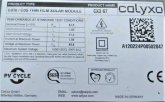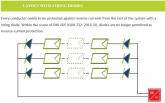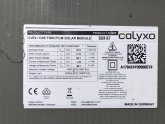Greetings from Bulgaria!
I'm totaly beguiner in this solar field, but this forum is great and I learn many new things here!
I bought some second hand thin layer PV pennels and want to made solar system for my house, mainly for the thermo pump heating in the cold months (from September to May here).
My plan is to use about 150 from those pannels (60x120 cm 65W max) with 2 ps of 5kw, 48V invertors in paralel + betteryes (I didn't decide which type to use yet).
The problem that I face is the high PV output voltage of those pannels - 45V (please see the PV panel specc table attached). The inverters that I choose (not ordered yet) are the MPP Solar PIP 5048 MGX with max PV input of 450V and 5000W.
My idea is to connect 8 pannels in series for one string ( will be 360V at 45W )and then to use 9 such strings in parallel with final PV output of 360V at 405V from 72 pannels in total. having 2 indentical sets like this will receive about 8kw at 720V from 144 pannels and if this is spited by the 2 inverters should be fine?
What you think for this theory design? Will it work fine or I should try to get higher Voltage or Wats to the invertors?
Thanks in advance!
BR
Alexander
I'm totaly beguiner in this solar field, but this forum is great and I learn many new things here!
I bought some second hand thin layer PV pennels and want to made solar system for my house, mainly for the thermo pump heating in the cold months (from September to May here).
My plan is to use about 150 from those pannels (60x120 cm 65W max) with 2 ps of 5kw, 48V invertors in paralel + betteryes (I didn't decide which type to use yet).
The problem that I face is the high PV output voltage of those pannels - 45V (please see the PV panel specc table attached). The inverters that I choose (not ordered yet) are the MPP Solar PIP 5048 MGX with max PV input of 450V and 5000W.
My idea is to connect 8 pannels in series for one string ( will be 360V at 45W )and then to use 9 such strings in parallel with final PV output of 360V at 405V from 72 pannels in total. having 2 indentical sets like this will receive about 8kw at 720V from 144 pannels and if this is spited by the 2 inverters should be fine?
What you think for this theory design? Will it work fine or I should try to get higher Voltage or Wats to the invertors?
Thanks in advance!
BR
Alexander








